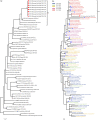An Outbreak of Severe Neonatal Pneumonia Caused by Human Respiratory Syncytial Virus BA9 in a Postpartum Care Centre in Shenyang, China
- PMID: 35863015
- PMCID: PMC9430609
- DOI: 10.1128/spectrum.00974-22
An Outbreak of Severe Neonatal Pneumonia Caused by Human Respiratory Syncytial Virus BA9 in a Postpartum Care Centre in Shenyang, China
Abstract
Human respiratory syncytial virus (HRSV) is a major pathogen of lower respiratory tract infections in children (<5 years) and older individuals, with outbreaks mainly reported among infants in hospital pediatric departments and intensive care units (ICUs). An outbreak of severe neonatal pneumonia occurred in a postpartum center in Shenyang city, China, from January to February 2021. In total, 34 respiratory samples were collected from 21 neonates and 13 nursing staff. The samples were screened for 27 pathogens using a TaqMan low-density array, and 20 samples tested positive for HRSV, including 16 neonates and 4 nursing staff samples. Among the 16 hospitalized neonates, seven were admitted to an ICU and nine to general wards. Four of the nursing staff had asymptomatic infections. To investigate the genetic characteristics of the HRSV responsible for this outbreak, the second hypervariable region (HVR2) sequences of the G gene were obtained from six neonates and two nursing staff. Phylogenetic analyses revealed that all eight sequences (SY strains) were identical, belonging to the HRSV BA9 genotype. Our findings highlight the necessity for strict hygiene and disease control measures so as to prevent cross-infection and further avoid potential outbreaks of severe infectious respiratory diseases. IMPORTANCE Human respiratory syncytial virus (HRSV) is one of the leading causes of acute lower respiratory infections (ALRI) worldwide. In this study, we first reported an outbreak of severe neonatal pneumonia caused by HRSVB BA9 at a postpartum care center in mainland China. Among 20 confirmed cases, 16 were hospitalized neonates with 7 in the ICU ward, and the other four were nursing staff with asymptomatic infections. Our findings highlighted the importance of preventing cross-infection in such postpartum centers.
Keywords: BA9 genotype; human respiratory syncytial virus (HRSV); neonatal pneumonia; outbreak; postpartum care center.
Conflict of interest statement
The authors declare no conflict of interest.
Figures

Similar articles
-
Genetic variation of human respiratory syncytial virus among children with fever and respiratory symptoms in Shanghai, China, from 2009 to 2012.Infect Genet Evol. 2014 Oct;27:131-6. doi: 10.1016/j.meegid.2014.07.011. Epub 2014 Jul 19. Infect Genet Evol. 2014. PMID: 25046173
-
Predominance of ON1 and BA9 genotypes of human respiratory syncytial virus in children with acute respiratory infection in Chiang Mai, Thailand, 2020-2021.J Infect Public Health. 2023 Sep;16(9):1418-1426. doi: 10.1016/j.jiph.2023.07.009. Epub 2023 Jul 20. J Infect Public Health. 2023. PMID: 37482015
-
The significance of human respiratory syncytial virus (HRSV) in children from Ghana with acute lower respiratory tract infection: A molecular epidemiological analysis, 2006 and 2013-2014.PLoS One. 2018 Sep 10;13(9):e0203788. doi: 10.1371/journal.pone.0203788. eCollection 2018. PLoS One. 2018. PMID: 30199549 Free PMC article.
-
Respiratory syncytial virus infections in human beings and in cattle.J Infect. 1994 Sep;29(2):215-28. doi: 10.1016/s0163-4453(94)90866-4. J Infect. 1994. PMID: 7806887 Review.
-
Characterization of human respiratory syncytial virus in children with severe acute respiratory infection before and during the COVID-19 pandemic.IJID Reg. 2024 Mar 21;11:100354. doi: 10.1016/j.ijregi.2024.03.009. eCollection 2024 Jun. IJID Reg. 2024. PMID: 38596821 Free PMC article. Review.
Cited by
-
An outbreak of human respiratory syncytial virus infection in the rural community of Zhejiang Province in 2023.Ann Med Surg (Lond). 2025 May 29;87(7):4687-4691. doi: 10.1097/MS9.0000000000003422. eCollection 2025 Jul. Ann Med Surg (Lond). 2025. PMID: 40851933 Free PMC article.
-
Enhanced Pathogenic Consequences Induced by a Seven-Amino-Acid Extension in the G Protein of the HRSV BA9 Genotype.Int J Mol Sci. 2025 Feb 27;26(5):2081. doi: 10.3390/ijms26052081. Int J Mol Sci. 2025. PMID: 40076707 Free PMC article.
-
An outbreak of rhinovirus infection in a primary school in Shenyang City, China, in 2022.Biosaf Health. 2024 Sep 11;6(5):298-303. doi: 10.1016/j.bsheal.2024.09.004. eCollection 2024 Oct. Biosaf Health. 2024. PMID: 40078735 Free PMC article.
-
Global outbreaks of respiratory syncytial virus infections from 1960 to 2025: a systematic review and meta-analysis.EClinicalMedicine. 2025 Jul 10;86:103352. doi: 10.1016/j.eclinm.2025.103352. eCollection 2025 Aug. EClinicalMedicine. 2025. PMID: 40666171 Free PMC article.
-
[Interpretation of "Expert recommendations for the prevention of common respiratory viral infections in neonates": problems faced by respiratory syncytial virus infection in neonates].Zhongguo Dang Dai Er Ke Za Zhi. 2025 Jan 15;27(1):26-32. doi: 10.7499/j.issn.1008-8830.2409033. Zhongguo Dang Dai Er Ke Za Zhi. 2025. PMID: 39825648 Free PMC article. Review. Chinese.
References
-
- Shi T, McAllister DA, O'Brien KL, Simoes EAF, Madhi SA, Gessner BD, Polack FP, Balsells E, Acacio S, Aguayo C, Alassani I, Ali A, Antonio M, Awasthi S, Awori JO, Azziz-Baumgartner E, Baggett HC, Baillie VL, Balmaseda A, Barahona A, Basnet S, Bassat Q, Basualdo W, Bigogo G, Bont L, Breiman RF, Brooks WA, Broor S, Bruce N, Bruden D, Buchy P, Campbell S, Carosone-Link P, Chadha M, Chipeta J, Chou M, Clara W, Cohen C, de Cuellar E, Dang D-A, Dash-Yandag B, Deloria-Knoll M, Dherani M, Eap T, Ebruke BE, Echavarria M, de Freitas Lázaro Emediato CC, Fasce RA, Feikin DR, Feng L, et al. 2017. Global, regional, and national disease burden estimates of acute lower respiratory infections due to respiratory syncytial virus in young children in 2015: a systematic review and modelling study. Lancet 390:946–958. doi: 10.1016/S0140-6736(17)30938-8. - DOI - PMC - PubMed
Publication types
MeSH terms
LinkOut - more resources
Full Text Sources
Medical

